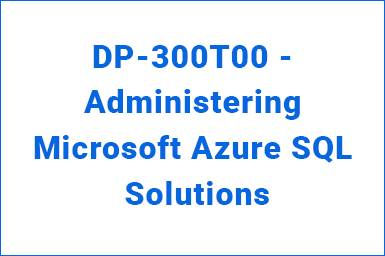DP-300T00 – Administering Microsoft Azure SQL Solutions
This course provides students with the knowledge and skills to administer a SQL Server database infrastructurefor cloud, on-premises and hybrid relational databases and who work with the Microsoft PaaS relationaldatabase offerings. Additionally, it will be of use to individuals who develop applications that deliver content from SQL-based relational databases.
Explore the role of a database administrator on Azure. Describe SQL Server-based offerings on Azure.
Click here to know more details
Configure virtual machine sizing, storage, and networking options to ensure adequate performance for your database workloads. Choose and configure appropriate high availability options.
Click here to know more details
Provision and deploy Azure SQL Database and Azure SQL managed instance. Select the appropriate options when performing a migration to the SQL PaaS platform.
Click here to know more details
Describe database migration options and tools on Azure. Understand how compatibility level affects database behavior. Describe Azure private and public preview options.
Click here to know more details
In this module, you will learn to demonstrate the benefits and processes for moving a SQL Server database to Azure SQL Database.
Click here to know more details
Learners will be able to demonstrate the benefits and processes for moving a SQL Server database to an Azure SQL Database Managed Instance.
Click here to know more details
Contrast authentication using Azure Active Directory, Windows Active Directory, and SQL Server authentication. Implement various security principals and configure permissions.
Click here to know more details
Explore encryption options available within Azure SQL, including firewall rules, Always Encrypted, and Transport Layer Security. Understand how SQL Injection works.
Click here to know more details
Explore data classification capabilities and degrees of confidentiality. Implement security options to maintain private data safe, including Azure SQL auditing, Microsoft Defender for SQL, row-level security, Dynamic Data Masking and Azure SQL Database Ledger.
Click here to know more details
Compare Azure, and on-premises tools for monitoring and measuring performance. Determine critical metrics. Understand the purpose of a baseline for comparative analysis. Configure extended event sessions for tracing activities.
Click here to know more details
Choose the appropriate size and storage options for your Azure SQL databases. Configure server resources such as tempdb. Understand the usage of Resource Governor.
Click here to know more details
Implement tasks for both IaaS and PaaS to maintain indexes, and statistics. Explore the automatic tuning features of Azure SQL Database. Control database-level configuration options. Explore Intelligent QueryProcessing.
Click here to know more details
Read and understand various forms of execution plans. Compare estimated vs actual plans. Learn how and why plans are generated. Understand the purpose and benefits of the Query Store.
Click here to know more details
Evaluate possible changes to indexes. Determine the impact of changes to queries and indexes. Explore Query Store hints.
Click here to know more details
Explore normalization for relational databases. Investigate the impact of proper datatype usage. Compare types of indexes.
Click here to know more details
Explore multiple deployment models available on Azure. Use Azure Resource Manager (ARM) templates and Bicep files for deploying Azure SQL resources. Understand how to use PowerShell and Azure CLI for automation purposes.
Click here to know more details
Explore SQL automation for scheduled tasks, and automatic alerts for SQL Server and Azure SQL Managed Instance.
Click here to know more details
Explore automation for Azure SQL platform. Configure elastic jobs, explore Azure Automation, and evaluate different strategies for monitoring automation tasks.
Click here to know more details
Plan an appropriate high availability and disaster recovery strategy based on recovery time objective and recovery point objective. Choose the best solution for IaaS or PaaS deployments or hybrid workloads.
Click here to know more details
Deploy Windows Server Failover Cluster and availability groups in Azure and hybrid environments. Configure temporal tables, geo-replication, and auto-failover groups.
Click here to know more details
Plan and implement policy for recovering data if user errors occur or the technology fails. Explore various options for how and where to back up and restore databases.
Click here to know more details
The audience for this course is data professionals managing data and databases who want to learn about administering the data platform technologies that are available on Microsoft Azure. This course is also valuable for data architects and application developers who need to understand what technologies are available for the data platform with Azure and how to work with those technologies through applications.
and technical knowledge of cloud technologies.
Specifically:
At a minimum, you should know the information in the following training before attending the course:
Skills Measured


To be added

